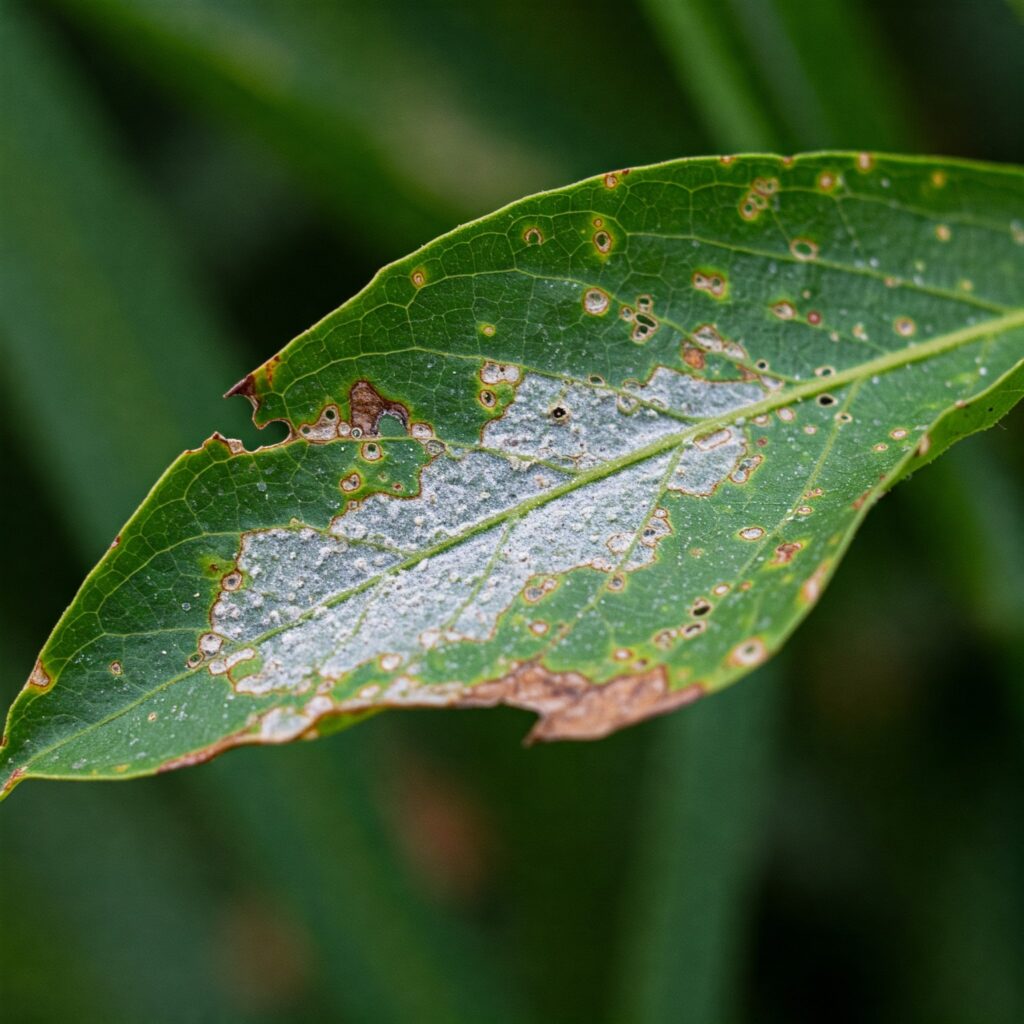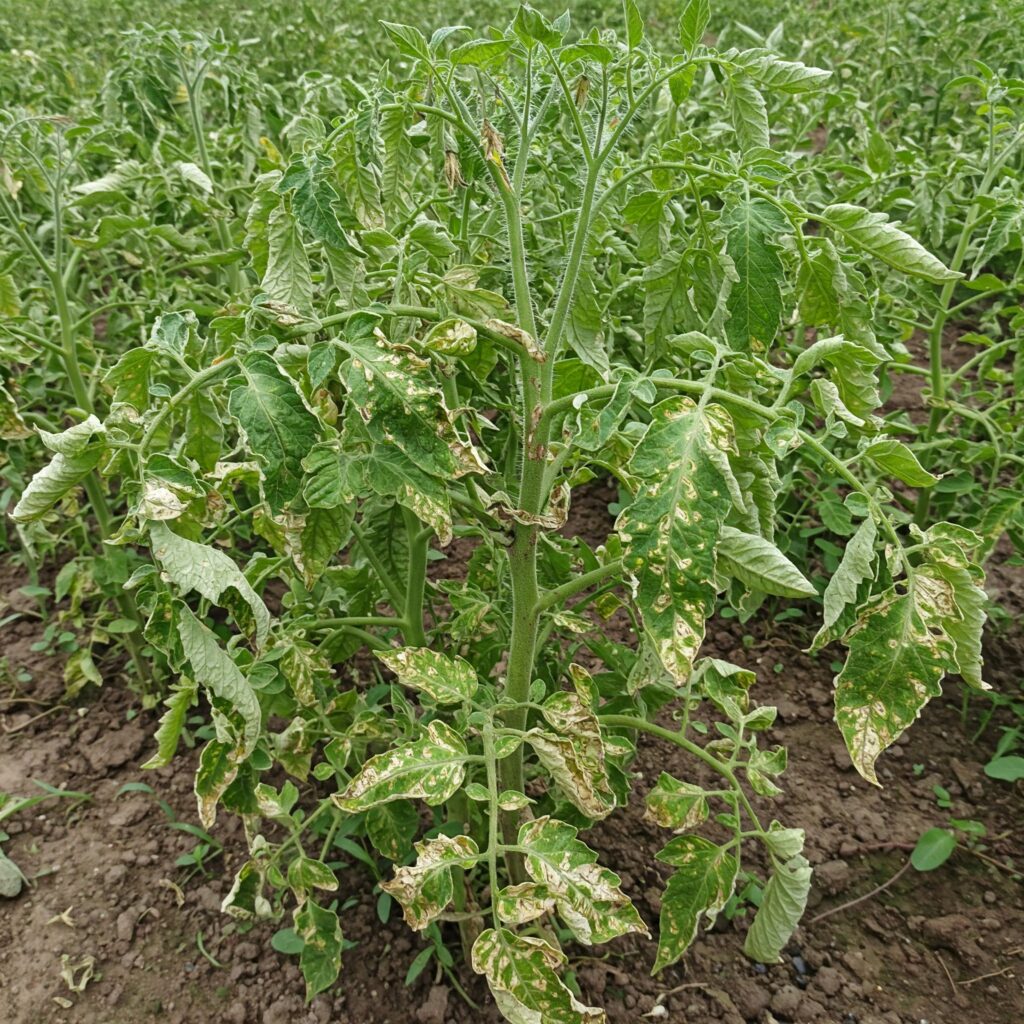Delving into Powdery Mildew: Biology, Life Cycle, and Predisposing Factors
To effectively combat powdery mildew, it is crucial to understand in detail the biology and life cycle of the fungi that cause it. Powdery mildew is not caused by a single type of fungus, but by several fungi belonging to the order Erysiphales. These fungi are obligate parasites, meaning they need a living host to survive and reproduce.
The life cycle of powdery mildew begins with the germination of spores (conidia) on the surface of the host plant. This germination is favored by high relative humidity, although, unlike many other fungi, powdery mildew does not require free water on the leaf surface to infect. Once the spore germinates, it forms a germ tube that penetrates the epidermis of the plant through a specialized structure called an appressorium.

Within the epidermis, the fungus establishes haustoria, structures that allow it to absorb nutrients from the cells of the host plant. The mycelium, the network of fungal filaments, extends superficially over the leaf surface, forming the characteristic white or grayish layer.
Asexual reproduction is the primary way powdery mildew propagates. The fungus produces chains of conidia on specialized structures called conidiophores, which rise from the superficial mycelium. These conidia are easily dispersed by wind, insects, or physical contact, allowing the disease to spread rapidly to other parts of the same plant or to neighboring plants.
Under less favorable conditions, such as at the end of the growing season or under environmental stress, some powdery mildew fungi may enter a phase of sexual reproduction. This results in the formation of tiny, dark fruiting bodies called cleistothecia (or chasmothecia). These cleistothecia contain ascospores, which are more resistant to adverse conditions and can survive during the winter in infected plant debris or in buds. In the following spring, the ascospores are released and can initiate new primary infections.
Predisposing Factors:
- High Relative Humidity with Moderate Temperatures: These environmental conditions are ideal for spore germination and mycelial development.
- Poor Air Circulation: Stagnant air around plants creates humid microclimates that favor fungal development.
- Shade: Plants in shaded areas tend to remain moist for longer, increasing the risk of infection.
- Excessive Nitrogen Fertilization: Lush and tender foliage growth, resulting from excess nitrogen, can make plants more susceptible to powdery mildew attack.
- Water Stress: Both insufficient and excessive watering can weaken plants and make them more prone to diseases.
- Varietal Susceptibility: Some plant varieties are genetically more susceptible to powdery mildew than others.

Advanced Strategies for Powdery Mildew Management and Control
In addition to the basic solutions mentioned above, there are more advanced and detailed strategies for the management and control of powdery mildew:
Comprehensive Preventative Management:
- Selection of Resistant Varieties: Researching and selecting plant varieties that demonstrate resistance or tolerance to powdery mildew is the first line of defense. Seed catalogs and recommendations from agricultural extension agents often indicate the susceptibility of different varieties to common diseases.
- Optimization of Air Circulation: When planting, ensure sufficient spacing between plants to allow for good air circulation. In greenhouses or enclosed spaces, use fans to keep the air moving and reduce localized humidity. Strategic pruning of dense branches can also improve air circulation within the plant.
- Adequate Irrigation: Water plants at the soil level, avoiding wetting the foliage. Morning watering allows leaves to dry quickly during the day, reducing the duration of moisture that favors spore germination. Adjust the frequency and amount of irrigation according to the specific needs of the plant and weather conditions.
- Fertilization Management: Avoid over-fertilizing with nitrogen, as this can promote susceptible foliar growth. Opt for balanced fertilization that promotes overall plant health. Soil tests can help determine the exact nutritional needs of your plants.
- Regular Monitoring: Inspect your plants regularly for the first signs of powdery mildew. Early detection allows for more effective intervention and prevents widespread disease spread. Pay close attention to young leaves and shaded parts of the plant.
- Removal of Infected Plants or Parts: If powdery mildew is detected, immediately prune and remove the affected parts of the plant. Dispose of these parts safely, away from healthy plants, to prevent spore dispersal. In severe cases, it may be necessary to remove the entire infected plant.
- Soil Solarization: In areas where powdery mildew has been a recurring problem, soil solarization can help reduce the population of soilborne pathogens, including cleistothecia that may have overwintered.
Specific Treatments:
- Sodium or Potassium Bicarbonate: These alkaline solutions can alter the pH of the leaf surface, making it difficult for powdery mildew spores to germinate. Mix 1 teaspoon of sodium or potassium bicarbonate in 1 liter of water and add a few drops of non-detergent liquid soap as a surfactant. Apply the solution by thoroughly spraying all plant surfaces, especially the affected areas. Repeat the application every 7-14 days, taking care not to apply in hot or direct sunlight to avoid leaf burn.
- Neem Oil: This natural oil has fungicidal and insecticidal properties. It works by interfering with fungal growth. Mix neem oil according to the manufacturer’s instructions and apply it as a foliar spray. It is important to cover all plant surfaces well, including the undersides of leaves. Applications should be repeated every 7-14 days.
- Sulfur: Sulfur is a fungicide traditionally used to control powdery mildew. It is available as a dusting powder or as a liquid spray. Carefully follow the manufacturer’s instructions for application and avoid using it at temperatures above 32°C (90°F) to prevent plant burn.
- Commercial Fungicides: Numerous commercial fungicides are specifically designed for powdery mildew control. These can be systemic (absorbed by the plant) or contact (act on the plant surface). Use these products strictly according to the label instructions, paying attention to dosage, application frequency, and safety precautions. Rotating different types of fungicides can help prevent the development of fungal resistance.
- Milk: A diluted milk solution (usually 1 part milk to 9 parts water) has shown some effectiveness in preventing and controlling powdery mildew, especially in cucurbits. It is believed that the proteins in milk act as a natural antiseptic. Apply the solution foliarly every 7-10 days.
Long-Term Management:
- Crop Rotation: In larger-scale agriculture, crop rotation can help reduce the accumulation of fungal inoculum in the soil and plant debris.
- Systemic Acquired Resistance (SAR) Induction: Some practices, such as the application of certain beneficial microorganisms or resistance inducers, can stimulate the plant’s natural defense mechanisms, making it more resistant to powdery mildew and other diseases.
Conclusion: An Integrated Approach for a Powdery Mildew-Free Garden and Crop
Successful management of powdery mildew requires an integrated approach that combines preventative strategies with timely and appropriate treatments. Understanding the biology of the fungus, identifying risk factors, and applying a combination of cultural practices, organic treatments, and, if necessary, commercial fungicides, will allow you to keep your plants healthy, productive, and free from the unsightly and damaging white layer of powdery mildew. Constant vigilance and early action are key to effective long-term control.
References:
- Agrios, G. N. (2005). Plant Pathology (5th ed.). Academic Press.
- Horst, R. K., & Cloyd, R. A. (2007). Compendium of Rose Diseases and Pests. APS Press.
- Williamson, M. (2017). Powdery Mildew. Royal Horticultural Society. https://www.rhs.de/ueber-uns
- [Include other specific references to relevant scientific studies or articles on powdery mildew and its control].
Keywords: Powdery mildew, fungal diseases, mildew control, mildew prevention, mildew treatment, sodium bicarbonate, neem oil, organic fungicides, integrated pest and disease management, plant pathology, Erysiphales, conidia, cleistothecia.
 AgronoBlog – Agriculture Blog
AgronoBlog – Agriculture Blog 
